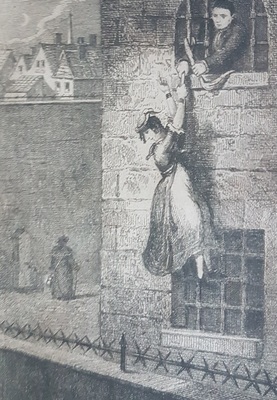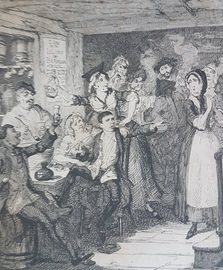 Famous historical criminals have usually had a woman by their side: Robin Hood (supp. fl. 12-13th centuries) supposedly had Maid Marian, while the twentieth-century bandit and murderer Clyde Barrow was accompanied in his criminal activities by his lover, Bonnie Parker. Robin Hood and Bonnie and Clyde continue to be household names even today. But if you lived during the eighteenth and nineteenth centuries, another criminal that would have been familiar to everybody was Jack Sheppard (1702-1724). And Sheppard was, like famous criminals before him, accompanied by a woman named Edgworth Bess, a sex worker. As this short article will show, Bess’ case highlights the way that sex work and criminality were perceived as being interconnected during the eighteenth century. Full details of Bess’ life will never be obtained. What little is known of her life is gleaned from the contemporary criminal biographies about Sheppard. Criminal biography was an immensely popular genre of literature during the seventeenth and eighteenth centuries. However, many of the details of offenders’ lives that these biographers were often invented or highly embellished. Bess was born, apparently, in the county of Middlesex in the early eighteenth century. Of her appearance very few details are told in the various sources. The only thing that comes near to describing what she looked like is a passing comment in Charles Johnson’s Lives of the Most Remarkable Criminals (1735) that she was ‘a large masculine woman’.[i] Indeed, she must have been formidable, for Johnson records that when she was drunk, which was often, she used to beat the slightly-built Sheppard during their quarrels.[ii] Before Bess met Sheppard, she was reputedly wife of a soldier but also a prostitute, having led ‘a wicked and debauched life’.[iii] To contemporary journalists, Bess was a temptress who, like Eve in the Bible, led unsuspecting male victims down a path of sin and vice. For example, when speaking of Sheppard, Johnson’s Lives and Exploits of the Most Noted Highwaymen (1734) says that The history of this unfortunate man affords another to the many examples of already given in this volume, that the company of profligate women have plunged men into scenes of dissipation and vice.[iv] Sheppard, so contemporary accounts tell us, began his working career as an industrious carpenter’s apprentice but it is Bess who leads him astray: The lad proved an early proficient, had a ready and ingenious hand, and soon became master of his business, and gave entire satisfaction to his master’s customers, and had the character of a very sober and orderly boy […]Alas, unhappy youth! Before he had completed six years of his apprenticeship he commenced a fatal acquaintance with one Elizabeth Lyon, otherwise known as Edgworth Bess […] Now was laid the foundation of his ruin![v] But how, exactly, was Bess responsible for bringing Jack to a life of crime? Firstly, she convinced him that ‘they must cohabit together as man and wife’.[vi] She then convinced Sheppard to steal items for her on multiple occasions, threatening to end their relationship if he did not do so. At first they were small items, but having introduced Sheppard to other thieves in the Georgian underworld such as Joseph Blueskin Blake, his robberies became greater in number. The idea of a person falling into a life of vice through a series of stages was a recurrent one during the eighteenth century. Andrea McKenzie says that, It was a commonplace of seventeenth- and eighteenth-century thought (if by no means new or unique to the period) that sin was both addictive and progressive. Contemporary moralists warned that from such little acorns as childhood raids on orchards and the pilfering of ‘Farthings and Marbles’ grew great oaks of iniquity.[vii] Temptation could come from bad associations also, which is an echo of the Bible’s command at 1 Corinthians 15: 33 which states that ‘bad company corrupts good morals’. And it was usually through a prostitute that unsuspecting good youths could be led astray down a bad path. Clearly this is the case with Sheppard, who as the accounts show was enticed by Edgworth Bess into a life of crime. The pair’s first brush with the law came when Sheppard and Bess stole a watch from a gentlemen as they were passing through Leicester Fields (now Leicester Square). The hue and cry was raised and Sheppard was captured, but Bess got away. Sheppard was consequently detained in St. Ann’s Roundhouse in Soho. When Bess went to visit him the next morning, she too was arrested, having been implicated in the robbery the day before. Remarkably, however, Sheppard and Bess managed to escape. With a file, Sheppard sawed off his and Bess’ fetters, cut an iron bar out of the window, and descended 25 feet down the walls of the prison by fastening a blanket to the remaining iron bars and lowering himself and Bess down.[viii] As soon as he was out, Sheppard turned again to robbery: Sheppard, not warned by this admonition, returns like a dog to his vomit.[ix] Sheppard managed to escape from gaol a further four times, and once with Bess’ help, when she visited him in gaol and secretly gave him the tools with which to carry out his escape. Sheppard was hanged on 16 November 1724. It is not known if she attended the execution of her lover, and history is silent in all particulars of Bess’ life after that. There was an Elizabeth Lyons who gave evidence in a trial at the Old Bailey on 16 April 1740,[x] and then there is an Elizabeth Lyons listed as a defendant in a trial at the Old Bailey on 28 April 1742.[xi] It is unknown, however, if these two Elizabeth Lyons are the same person as the prostitute with whom Jack Sheppard was enamoured. Whatever the circumstances of her later life, Bess did enjoy a ‘literary afterlife’. This came in the next century with William Harrison Ainsworth’s novel Jack Sheppard (1839). In this novel, she comes across as quite a mean-spirited character: changeable and indifferent to Jack’s fate. Ainsworth’s novel was plagiarised several times: in Lincoln Fortescue’s Life and Adventures of Jack Sheppard (1845); in the anonymously authored penny serial Jack Sheppard; or, London in the Last Century (1847); and in The Real Life and Times of Jack Sheppard (c.1850). In addition to these novels, she also appears in entries on Jack Sheppard in the numerous reprints of The Newgate Calendar (1825) and Camden Pelham’s The Chronicles of Crime; or, The New Newgate Calendar (1887). All of these publications presented Bess in the same way that Defoe and Ainsworth had done: a treacherous, wicked woman. An altogether more positive portrayal of Bess came in the little-known movie Where’s Jack? (1969). However, while the movie is certainly an entertaining watch, the producers were liberal in their interpretation of historical sources. Bess is not a sex worker in the movie, and far from being a temptress, she actually tries to steer Jack away from a life of crime. We will never know the actual details of Bess’ life. She will always be a woman whose life can only be partially glimpsed through highly embellished contemporary sources. Indeed, this post fails itself fails the Bechdel test: this historical marginalised woman will only ever be known, and can only ever be spoken about with reference to Sheppard. But her case does highlight the apparent relationship between sex work and criminality that many people in the eighteenth century assumed existed. References: Image Credits: Fig. 1: Lincoln Fortescue, Life and Adventures of Jack Sheppard: A New Edition (London: J. Cochrane, 1845). Stephen Basdeo – Personal Collection. Fig. 2: William Harrison Ainsworth, Jack Sheppard: A Romance 3 Vols. (London: S. Bentley, 1839). Stephen Basdeo – Personal Collection. Works Cited: [i] Charles Johnson, Lives of the Most Remarkable Criminals ed. by Arthur Heyward (London: Routledge, 1927), p.182. [ii] Johnson, Lives of the Most Remarkable Criminals, p.182. [iii] ‘The History of the Remarkable Life of John Sheppard’ in Defoe on Sheppard and Wild ed. by Richard Holmes (London: Harper, 2004), p.6 [iv] Charles Johnson, Lives and Exploits of the Most Noted Highwaymen (London, 1724; repr. London: T. Tegg, 1839), p.367. [v][v] ‘The History of the Remarkable Life of John Sheppard’, pp.5-6. [vi] ‘The History of the Remarkable Life of John Sheppard’, p.6. [vii] Andrea McKenzie, Tyburn’s Martyrs: Execution in England, 1675-1775 (London: Hambledon, 2007), p.59. [viii] ‘The History of the Remarkable Life of John Sheppard’, p.10. [ix] Ibid. [x] Anon. The Proceedings of the Old Bailey 16 April 1740 (t17400416-37) [Internet <http://www.londonlives.org/browse.jsp?div=t17400416-37> Accessed 14 December 2016]. [xi] Anon. The Proceedings of the Old Bailey 28 April 1742 (t17420428-14) [Internet <http://www.londonlives.org/browse.jsp?id=t17420428-14> Accessed 12 March 2016].
0 Comments
Leave a Reply. |
Sex History ContentsIf you would like to submit an article, please fill out a submission on the Contact page Archives
September 2020
|

 RSS Feed
RSS Feed